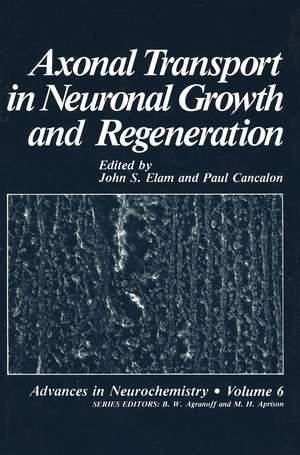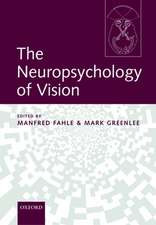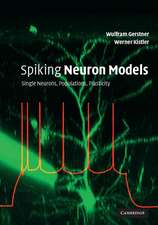Axonal Transport in Neuronal Growth and Regeneration: Advances in Neurochemistry, cartea 22
Editat de John Elamen Limba Engleză Paperback – 15 feb 2013
Preț: 387.75 lei
Nou
Puncte Express: 582
Preț estimativ în valută:
74.22€ • 80.65$ • 62.38£
74.22€ • 80.65$ • 62.38£
Carte tipărită la comandă
Livrare economică 22 aprilie-06 mai
Preluare comenzi: 021 569.72.76
Specificații
ISBN-13: 9781468411997
ISBN-10: 1468411993
Pagini: 304
Ilustrații: XVI, 284 p. 43 illus.
Dimensiuni: 152 x 229 x 16 mm
Greutate: 0.41 kg
Ediția:Softcover reprint of the original 1st ed. 1984
Editura: Springer Us
Colecția Springer
Seria Advances in Neurochemistry
Locul publicării:New York, NY, United States
ISBN-10: 1468411993
Pagini: 304
Ilustrații: XVI, 284 p. 43 illus.
Dimensiuni: 152 x 229 x 16 mm
Greutate: 0.41 kg
Ediția:Softcover reprint of the original 1st ed. 1984
Editura: Springer Us
Colecția Springer
Seria Advances in Neurochemistry
Locul publicării:New York, NY, United States
Public țintă
ResearchCuprins
1 Axoplasmic Transport in Relation to Nerve Fiber Regeneration.- 1. Introduction.- 2. Models Proposed for Regeneration.- 3. The Transport Filament Model.- 4. Slow Transport as a Drop Off and Turnover of Components.- 5. Routing in Relation to Transport and Regeneration.- 6. A Hypothesis for Selective Neurite Growth on the Basis of Routing.- 7. References.- 2 Basic Properties of fast Axonal Transport and the Role of fast Transport in Axonal Growth.- 1. Introduction.- 2. Structures in Fast Axonal Transport.- 3. Organization of Fast Axonal Transport.- 4. Molecular Bases of Movement.- 5. Role of Fast Axonal Transport in Axonal Growth and Regeneration.- 6. References.- 3 Retrograde Signaling after Nerve Injury.- 1. Nerve Cell Body Response to Axotomy.- 2. Retrograde Axonal Transport: Physiological Significance.- 3. Chromatolysis and Retrograde Axonal Transport: Time Relationship.- 4. Possible Signal Mechanisms Mediated by Retrograde Transport.- 5. Retrograde Transport during Regeneration.- 6. Concluding Remarks.- 7. References.- 4 Retrograde Axonal Transport and Nerve Regeneration.- 1. Introduction.- 2. Retrograde Transport following Axonal Injury.- 3. Changes in Retrograde Transport during Regeneration.- 4. Control of Regeneration Rate.- 5. Conclusion.- 6. References.- 5 Biochemical Aspects of the Regenerating Goldfish Visual System.- 1. Introduction.- 2. Behavioral Evaluation of Recovered Visual Function.- 3. Expiant Culture.- 4. Retinal Incubations.- 5. Axonal Transport of Proteins Associated with Regeneration.- 6. References.- 6 Axonal Transport of Glycoproteins in Regenerating Nerve.- 1. Functions and Growth-Related Changes in Glycoproteins of Nonneuronal Cells.- 2. Glycoproteins and Neuronal Growth.- 3. Axonal Transport of Glycoproteins in Mature and Growing Neurons.- 4. Axonal Transport of Glycoproteins in Regenerating Olfactory Nerve.- 5. Conclusions.- 6. References.- 7 Transport of Transmitter-Related Enzymes: Changes after Injury.- 1. Introduction.- 2. Methods.- 3. “Cholinergic” Enzymes.- 4. Adrenergic Enzymes.- 5. Other Enzymes.- 6. Conclusions.- 7. References.- 8 Transfer-Rna-Mediated Posttranslation al Aminoacylation of Proteins in Axons.- 1. Introduction.- 2. RNA is Present in Axons.- 3. RNA in Axons Is 4 S RNA.- 4. The 4 S RNA in Axons Is Transfer RNA.- 5. Transfer RNA in Axons Serves as an Amino Acid Donor in Posttranslational Protein Modification.- 6. Posttranslational Modification of Proteins by tRNA-Dependent Amino Acid Addition Occurs in Growth Cones of Regenerating Optic Axons of Goldfish.- 7. References.- 9 Molecular Events Associated with Peripheral Nerve Regeneration.- 1. Introduction.- 2. Methods.- 3. Protein Synthesis after Nerve Damage.- 4. Proteins Transported after Nerve Damage.- 5. Axon Regrowth without Changes in Synthesis or Transport.- 6. The Fate of Axonally Transported Proteins at Regrowing Tips.- 7. Conclusions.- 8. References.- 10 Target-Dependent and Target-Independent Changes in Rapid Axonal Transport During Regeneration of the Goldfish Retinotectal Pathway.- 1. Introduction.- 2. Qualitative Studies on the Changes in Rapidly Transported Proteins during Regeneration.- 3. Target Regulation of Rapidly Transported Proteins during Regeneration.- 4. Summary and Conclusions.- 5. References.- 11 Regulation of Axon Growth and Cytoskeletal Development.- 1. Introduction.- 2. Growth-Associated Proteins and Axon Growth.- 3. Regulation of the Neurofilament Cross-Linking Polypeptide during Neuronal Development.- 4. References.- 12 Effect of a Conditioning Lesion on Axonal Transport During Regeneration: the Roleof Slow Transport.- 1. Introduction.- 2. Effects of Conditioning Lesions on Axonal Transport.- 3. Discussion.- 4. References.- 13 The Relationship of Slow Axonal flow to Nerve Elongation and Degeneration.- 1. Introduction.- 2. Influence of Temperature on Mechanisms Involved in Neuronal Maintenance and Regeneration.- 3. Changes in Axonal Transport during Development and Regeneration.- 4. Regeneration of the Garfish Olfactory Nerve.- 5. Axonal Degeneration.- 6. Conclusions.- 7. References.- 14 Neurofilament Transport in Axonal Regeneration: Implications for the Control of Axonal Caliber.- 1. Introduction.- 2. Cytoskeletal Composition in Normal Nerves.- 3. Neurofilament Transport and Axonal Caliber in Regenerating Axons.- 4. Models for the Control of Axonal Caliber by Neurofilament Transport.- 5. Conclusion.- 6. References.- 15 Calcium-Activated Protease and the Regulation of the Axonal Cytoskeleton.- 1. Introduction.- 2. Calcium-Dependent Breakdown of the Axonal Cytoskeleton.- 3. Calcium-Activated Proteolysis of Axonal Cytoskeletal Proteins.- 4. Isolation of Calcium-Activated Protease from Neural Tissues.- 5. Turnover of Neurofilament Proteins and the Regulation of the Axonal Cytoskeleton.- 6. References.






















